
When the walls are sheathed with drywall, many begin to think about finishing. Such issues need to be addressed in advance, although this is not critical. The resulting smooth surface can be further prepared for painting, pasting with wallpaper, applying liquid wallpaper, laying tile and applying decorative plaster and. We will consider how plasterboard putty is used for wallpaper. This process is so simple and accessible that even a beginner can handle it.
It is most difficult to prepare plasterboard for decorative plaster and painting, and for further pasting with wallpaper it can be easily puttied with your own hands.
Content:
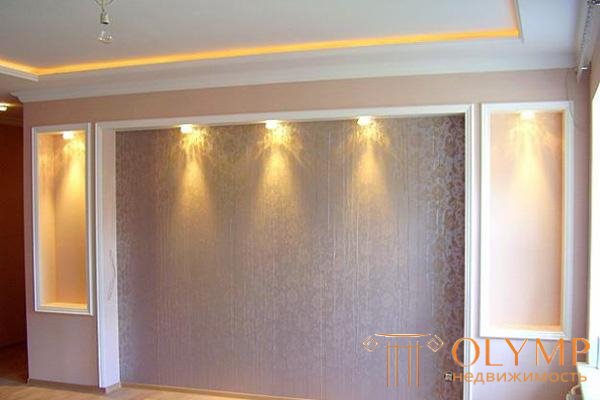
The appearance of the wall after pasting drywall wallpaper
It is clear that the joints of the sheets will be protected with special reinforcing tape and plastered. It is clear that the caps of the screws are also hidden under the layer of putty. However, not everyone knows whether to putty drywall before sticking wallpaper. This is a complete coating of the sheet with a special solution. Is it necessary?
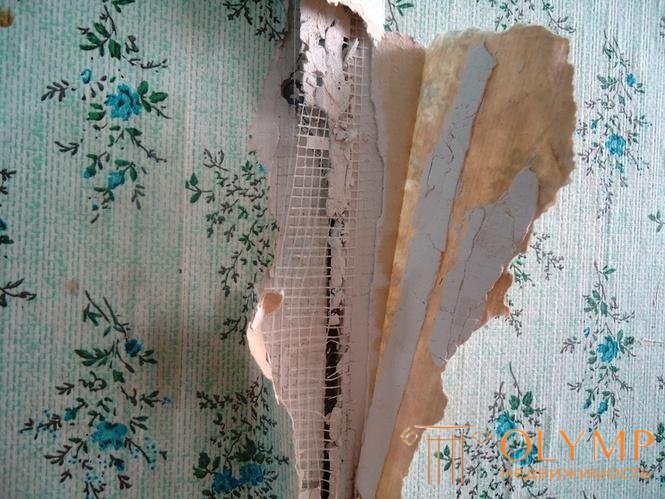
Consequences of the absence of a layer of putty on sheets of drywall
There are only two arguments, but they are very powerful. Another thing to note is that shrinkage is possible in the new building. So the wallpaper can start turning into a harmonica. Only correctly used drywall can save it (installed with gaps). Experts say that putty drywall under the wallpaper also helps, but this is only a theory, not proven in practice.
There is a mass of diverse products on the market that may be suitable for the intended purpose. Building supermarkets offer a wide selection, and it is easy to get lost in all this variety.
Since no one will glue wallpaper in rooms with high humidity, you can use the most common plaster putty. As for the kitchen, it is sometimes used cement-based putty in this room, but this is not critical.
It is necessary to give preference to a dry mixture, which can always be diluted with water in the desired amount.
The consumption of material and the order of its use is always marked on the package. Therefore, there should be no questions about the amount needed to work.
There is a starting and finishing putty, which are used at different stages of work. Do I need to putty drywall under the wallpaper with both putty? It's not obligatory. The starting solution is applied in a large layer and is used to seal cracks and level the surface. In the case of the use of drywall in this is not necessary, except for sealing joints. Therefore, you can use a finishing putty, which is applied in a thin layer and has a lower consumption.
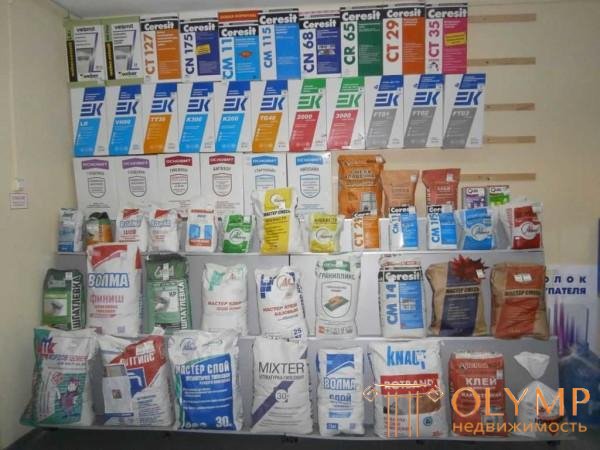
In the classic version, first use the starting and then finishing putty. But such a scheme will be more expensive.
Separately, I would like to dwell on polymer fillers. They are sold ready to use and easy to work with. They take longer to seize, which means that the beginner will have enough time to fix his shoals. However, the unused solution can be safely disposed of in the trash, since its shelf life after opening does not exceed a crescent.
With a brand, everyone must decide for himself. The most commonly used products are Knauf, Fugenfüller and Uniflot. However, you can take a less well-known products, if we are talking about a simple plaster putty in a dry form.
Properly selected tools greatly simplify the work. We will not consider a set of tools for working with drywall or pasting wallpaper. We are interested in at this stage only those devices with the help of which the plasterboard is putty under the wallpaper.
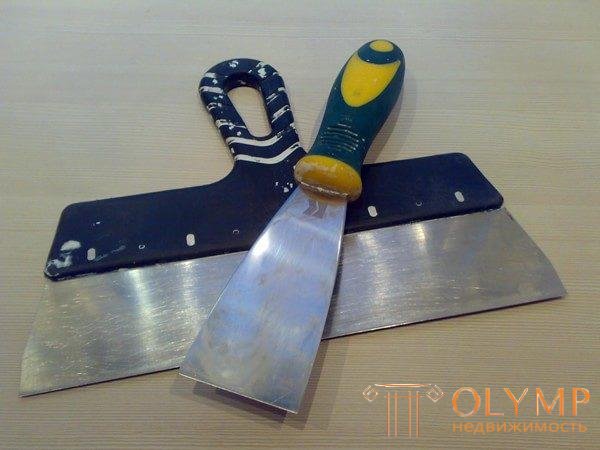
It looks like the minimum set of spatulas needed for work.
Separately, I would like to stay on the spatulas. They need at least two: with a blade width of 5-5-10 cm and 20-40 cm. A narrow spatula is used to set up the solution and transfer it to a wide spatula. Last put the putty directly on the wall. Also, a narrow spatula is used in places where you need to carefully add a little solution.
The spatula must be flexible and made of stainless steel. Then it will be convenient for them to work, and rust will not appear on the wall after some time.
We already understood whether it is necessary to putty drywall under the wallpaper before sticking. If the wallpaper in the future will change, then putty is definitely needed. But even drywall needs advance preparation. It is clear that nothing needs to be leveled, however there are certain nuances to which attention should be paid.
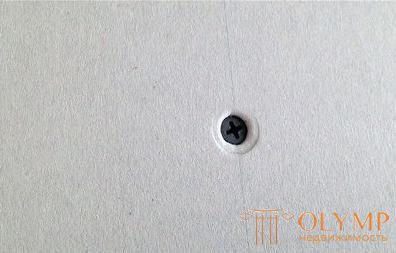
Screws should be screwed to such depth
Most often problems arise because of self-tapping screws. If the screw cap sticks out above the surface, the spatula will constantly cling to it. Therefore, you must immediately walk with a spatula across the wall to detect such defects. Screws need to screw a curly screwdriver enough to drown the hat in the plasterboard.
If somewhere the cardboard shell has detached from the plaster core, then it needs to be cut off in this place. In the future, the defective area will be puttyed simultaneously with the joints.
Sheet joints should also be prepared. The joining edges must be machined with a plane or a construction knife. From the edges it is necessary to chamfer at an angle of 450. The resulting edge will be good to putty. Factory chamfer (rounded edge of the sheet) do not need to touch.
Before you putty drywall under the wallpaper with your own hands, the wall will need to be cleaned from the remnants of dust and dirt that could appear at the previous stages of working with drywall. After that, you can do the priming surface.
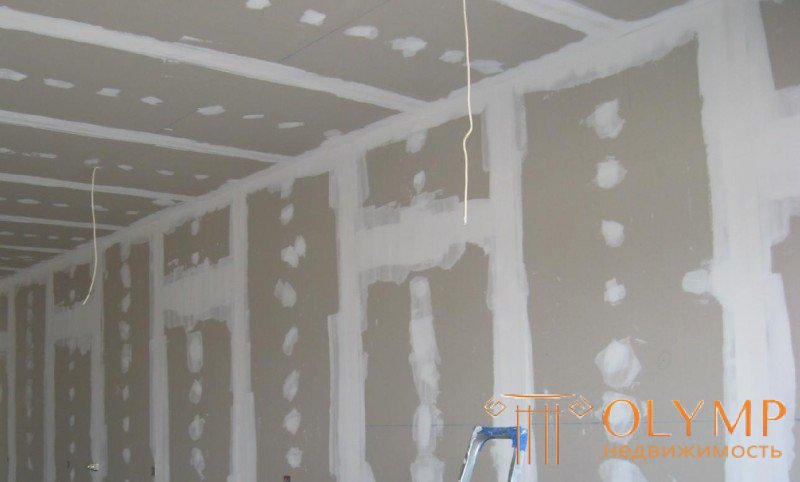
The appearance of the wall after putty joints and caps screws
At first it is necessary to putty the caps of screws and joints, and only then it will be possible to work with the entire surface. Screw caps and drywall joints are primed to improve the adhesion properties of the material. Also, this procedure will make the whole wall more uniform in color. Only after the complete drying of the primer layer can you begin to apply putty.
A small putty spatula is applied to the butt of the sheets with transverse movements. After the hollow is completely filled, a reinforcing tape (paper or serpyanka) is put on top of it. Fiberglass Serpyanka would be the best option. It will be extremely difficult for a beginner to work with a paper tape, because it tends to flatten out poorly.
With a wide trowel the serpyanka is pressed down to the surface with longitudinal movements. If everything is done correctly, the excess putty will come to the surface and end up on a wide spatula, from which they are periodically cleaned with a smaller spatula.
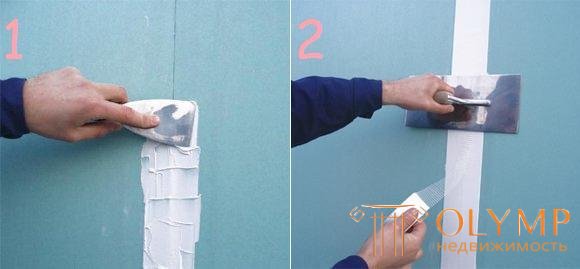
Seam sealing with serpyanka
The remains of putty from such a procedure are used for screws. The material is evenly ground on the surface as thin as possible. As a result, the heads and joints of the sheets will be covered with a layer of mortar, and the surface will become completely flat, without pits and hollows. Now it can be carried out a complete plastering of the walls of drywall under the wallpaper.
To putty more reliably attached to sheets of drywall they need to be treated with a water-based primer. It is enough with the help of a roller to walk across the wall twice, waiting for the first layer of primer to dry. When the second layer dries, it will be possible to mix the putty for work.

It is most convenient to apply a primer with a roller with an extended handle.
The solution is applied with a small spatula evenly on a large one. After that, the solution is smeared with a wave-like horizontal movements along the wall. You need to rub it like a thin layer of drywall.
You need to work with a small amount of material so that it doesn’t get bulge during the smearing on drywall. The solution is applied over the entire wall in a uniform layer, after which it is allowed to dry.
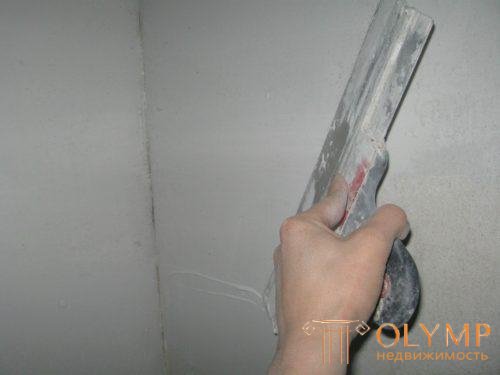
It is recommended to start work from the least noticeable corner of the room. The further the work progresses, the more thorough it will become, and all the flaws will remain where they are least visible.
It is necessary to carry out the plasterboard plasterboard under the wallpaper in two layers. Moreover, it is no longer necessary to prime it, because a peculiar coat has formed on the first layer, which will improve the adhesion of the second layer. Apply a new layer in the same way as the first one was applied. After that, the surface should dry (usually wait until the next day).
The dried surface has many rough edges, nodules and tubercles (the less experience, the more such defects). But all this is easily eliminated by grinding. You can use a regular grater with sandpaper planted on it. The entire wall is sanded and becomes smooth, just under the wallpapering.
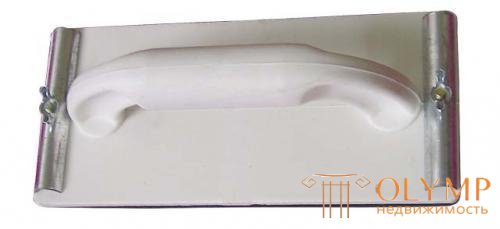
Special grater for attaching sandpaper to it
Now you know how to putty drywall under the wallpaper correctly. However, there are certain difficulties with working in the corners, so let us dwell on these points in more detail.
Particularly difficult during such repairs are angles. These are the same joints of drywall sheets, but at a right angle. It is necessary not only to close these joints, but also to leave the corners straight.
External corners must be strengthened with a plastic or metal angle. To do this, putty is applied to the entire area of the corner part, which is then pressed into the corner. You can pin down the rule for uniform pressure. Reinforcing angle is pressed to the limit, after which it will not otlipnet.
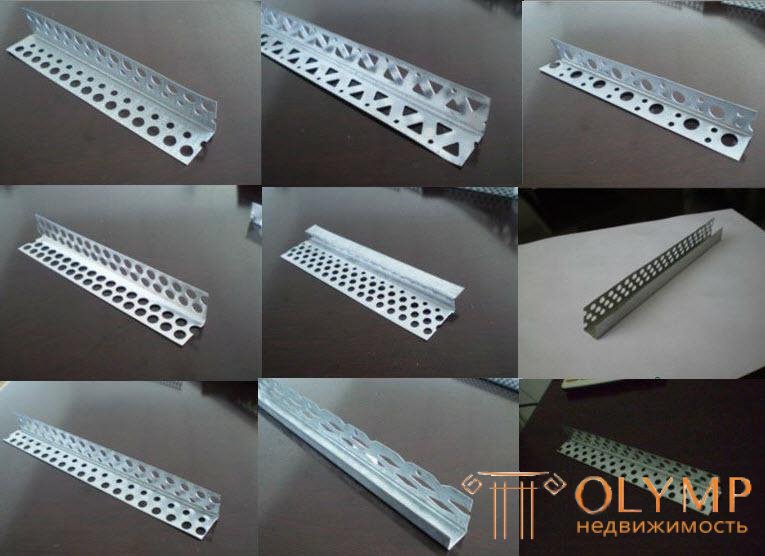
In such corners there is a perforation to exit the excess solution.
Squeezed putty smear along the wall from the corner. Since the reinforcing corner adds thickness, it is necessary to smear it so as to make a smooth transition. As a result, there should be no noticeable differences between the wall and the reinforcing corner.
Cheap galvanized corners tend to abrade the coating. Any careless movement of the trowel can damage the zinc layer. As a result, moisture will start to fall on the metal, which means it will not take long to wait for rust. Over time, a rust stain will appear in this place through the putty.
If you want to take exactly the metal corner (thinner than plastic), then it is better to give preference to aluminum products.
Putting drywall under the wallpaper with your own hands implies that from the first time not everything will turn out. Therefore, you need to be patient, especially with external corners. They are always in sight, the poet needs to do everything qualitatively.
Sometimes the reinforcing corners are placed on the outer joint and fastened with screws. Such a corner will firmly stay on the surface and will not fall away. After that, you can put a putty on him, without fear that he will go somewhere or fall off.
Many rely on a special spatula, made in the form of a corner. It is convenient for them to putty the corners, smearing the putty with vertical movements. However, this tool has drawbacks. Beginner with him will be difficult to cope. Also, if the drywall sheets do not form a right angle, then such a tool is useless, because it is designed for perfect walls.

The classic version of the work with the inner corner
Putty drywall under the wallpaper at the inner corners is performed using serpyanka. The tape is glued to both walls along the joint. And you need exactly two tapes on two walls, not overlapped. You can not bend the serpianka in half to stick on two walls at once. If you do this, then over time the wallpaper in the corners will start to move away. It is advisable to take a tape with a glue base so that you can stick it on evenly.
A layer of putty is applied over the serpyanka, which is smeared vertically, and then only horizontal movements from the angle are carried out with the clamping movements of the spatula. It will be correct to first make one wall completely, and then move on to the second wall.
After pasting wallpaper with a slight curvature of the inner corner will be invisible.
Что бы оставить комментарий войдите
Комментарии (0)